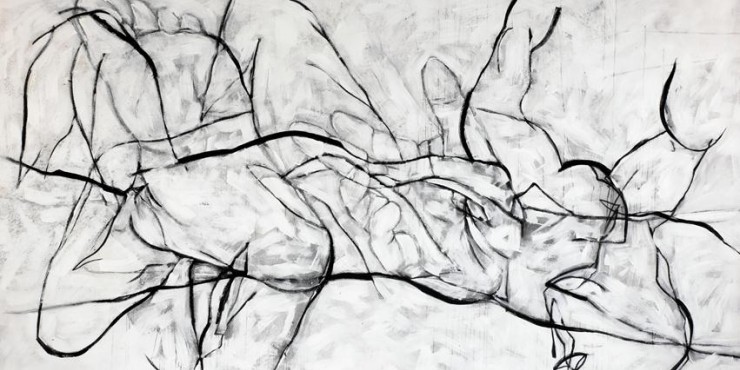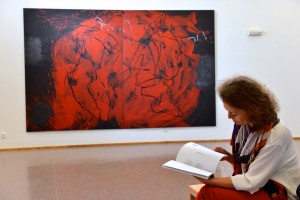
The exhibition of the Austrian painter Hannes Mlenek (1949 ) presented only one of the possible views on his work. His artistic activities are diverse, however, they are based on drawing. One of the texts about the artist's work is called Mentality of Drawing and it seems that this title semantically describes its character. The artist transformed into the crystalline essence the rich history of Austrian art and drawing from the Baroque through Expressionism and Viennese Actionism. In his work he expressed its spiritual line leading from ecstatic religious meditation through Kokoschka’s expressive figuration, Action painting up to Neo-expressionist methods. Drawing inspiration from this cultural heritage, he built up his system of “mental” drawings. His subjects are almost exclusively associated with the figure, which has become a systemic structure of various types of compositions and multimedia opuses. The figure in Mlenek’s work is not merely viewed as a figure, but as a spiritual overlap with the category of the universally “human”, exceeding at the same time the human dimension.
The exhibition at the Danubiana presented a selection from his large paintings from the last decade, but they are not his largest pictures. It also included several spatial (sculptural) objects – cosmic bodies, which seemed to have objectively documented the artist’s orientation beyond the borders of our perceptible world.
The human body as a visualised structure becomes a tangle of lines more or less following the original story. The dynamism of lines, their expressive clashes, penetrations and escapes becomes the major player of the picture, enabling it to transform smoothly from the figurative to the non-figurative. For Mlenek it is still the interface between the real and the unreal, the penetration of the boundaries between the sensory and the extrasensory. This aspect is highlighted by the treatment of colour, reduced to monochrome grey, black and white, with accents of red or black-red compositions. Space is an important part of his creative arrangements. The dynamism of action and gestural drawing in his two-dimensional works creates the impression of imaginary space. Indisputably, the painter possesses a remarkable skill to create a sense of space on the surface without using conventional space-creating methods.
Space is part of other areas of Mlenek’s work. Although these works were not exhibited, they should be briefly mentioned to provide a comprehensive view of his work. This will shed light on his relation to space and its treatment in various forms. At many of his exhibitions drawing was presented as a spatial element on perforated panels that made the exhibition space more dynamic. The artist's exterior forms and events – paintings in open space (on facades of buildings) – are of particular interest. In his major event, Landschaftsbilder, a gigantic painting with dimensions of 700 square metres was sited in a field and intended to be viewed from above; it was a parallel to Land art.
Mlenek’s impressive gigantic paintings on the ceiling and the floor accompanied by the sound environment Parsifal – Paraphrases were created in collaboration with the composer Karlheinz Essl. The paintings and music created an impressive meditative whole. The exhibition of Hannes Mlenek introduced our audiences to the work of a major figure of Austrian contemporary art and showed an unconventional creative conception of work with the medium of drawing.
Eva Trojanová











